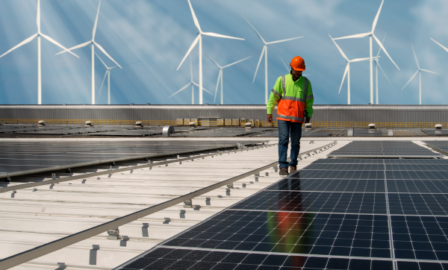Incorporating a Sustainable Transportation System into Your Supply Chain Strategy
Transportation infrastructure is becoming even more vital as businesses increase deliveries and strive to get the right product to the right door at the right time. While the delivery landscape changes and businesses adapt to customer needs, establishing and maintaining a sustainable transportation system in your supply chain is growing in importance. With 21% of worldwide greenhouse gas emissions resulting from the transportation industry, it’s a large contributor to climate change and must be incorporated into supply chain sustainability strategies.
To aid in the decarbonization effort, the U.S. National Blueprint for Transportation Decarbonization has been deployed and it endeavors for a transportation industry that is net-zero GHG emissions by 2050. With this goal, it’s crucial that businesses assess their current state and begin preparation for a rapidly changing landscape and increasingly aggressive sustainability goals.
Sustainable Transportation Systems for Supply Chains
What Does Sustainable Transportation Look Like?
Based on company goals and industry-specific requirements, sustainable transportation can vary from business to business. However, there are common areas to consider. Among the more well-known strategies, fuel efficiency and alternative fuel types typically use existing vehicles or modified versions of them to improve overall emissions. Fuels such as biodiesel, hydrogen, and renewable natural gas can often fit in the framework of an existing design that can aid in development and adoption.
Electric vehicles are also a technology at the forefront of the carbon shift and, in the right situation, can add significant value to decarbonization efforts. While assessing your options, it’s important to consider all alternatives and adopt more than one technology. Creating a diversified fuel strategy can spur short-term incremental change that can support company goals as larger and more impactful changes occur over time.
Another opportunity to create a more efficient and sustainable transportation system is to reduce partial truckloads by optimizing capacity. Reducing partial truckloads will improve cost-effectiveness and reduce greenhouse gas emissions. P&G has demonstrated this strategy by tapping into their logistics network in order to optimize carriers’ empty miles. Initiatives like these will help create a more sustainable transportation system over the coming decades, but it’s important to start gradually, receive buy in, and make steady progress over time.
Measuring Transportation Sustainability
There are many benefits of a sustainable transportation plan, and using sustainability as a metric to evaluate your transportation service providers can be an important addition to your selection criteria and also a great way to encourage others to evaluate and improve their processes. Working with other entities that have an eye on sustainability will ensure a common ground that will allow both parties to meet internal goals and make a larger overall impact.
Measuring that impact can be difficult, but establishing Key Performance Indicators (KPIs) is an essential first step to drive the business’s goals forward. While they vary, and should be tailored to specific business needs, the following are a sample of possible metrics.
- Year-over-year reduction of carbon emissions seems like an obvious place to start, but that’s intentional. It’s also a hard metric to measure, so tracking it forces a company to truly understand where they stand. Knowing the current state and the overall impact of efforts will help drive informed decisions regarding fuel strategy, investments, and other initiatives.
- Overall supply chain miles represent the total distance traveled, from raw material to final delivery, to produce an item or group of products. With this metric, the key is to limit multi-stop travel during procurement and production while assessing the best mode of transportation (i.e., air, rail, road). Keep in mind that not all miles are created equal when it comes to GHG emissions. Care must be taken to ensure the entire picture is seen.
- Reduction of partial truckloads can be difficult, but measuring and assessing opportunities to improve the current state is a crucial step to moving forward.
Where to Start?
While there are many factors to consider when creating a successful sustainable transportation system, it’s necessary to begin by understanding your current state, digging into any data or metrics that already exist, and utilizing this information to establish future goals. Developing a sustainable transportation strategy is no easy endeavor, and it will take time, effort, and resources; however, the evolution of green tactics will add flexibility to your supply chain and have a positive impact in the short and long term. Clarkston can help during this phase by leading an assessment of your current state, helping to evaluate modes of transport and available service providers as well as establish a roadmap and plan of action to ensure success against your future sustainability targets.
Connect with us to learn more about our supply chain sustainability services.
Subscribe to Clarkston's Insights
Contributions from Addie Schmidt



